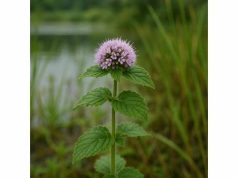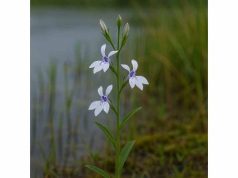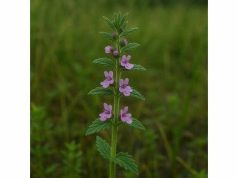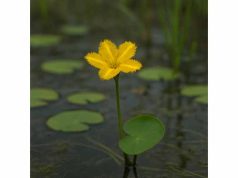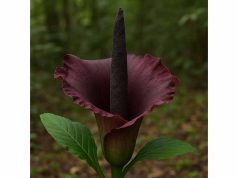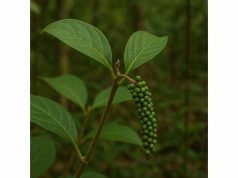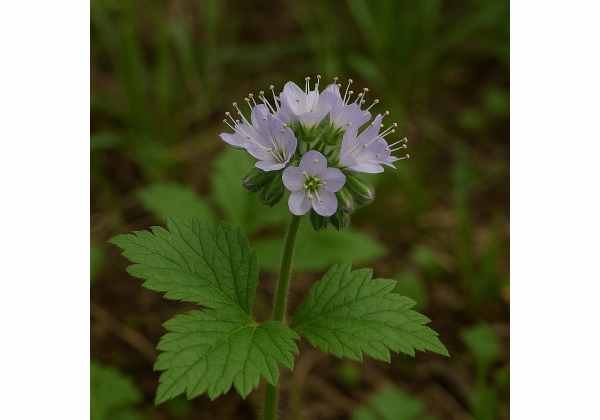
Virginia Waterleaf (Hydrophyllum virginianum) is a woodland wildflower prized for both its gentle edible greens and diverse therapeutic attributes. Laden with vitamin C, mucilage, flavonoids, and essential minerals, this low-growing plant has traditionally been used as a soothing emollient, mild diuretic, and digestive aid. Its tender leaves offer anti-inflammatory and demulcent properties, while leaf infusions can calm respiratory irritation and support urinary tract health. From crisp spring salads to nourishing poultices, Virginia Waterleaf bridges culinary delight with botanical medicine. Whether for immune support, skin care, or simple nourishment, this versatile herb continues to win favor among foragers and natural wellness enthusiasts alike.
Table of Contents
- Structure and Native Range
- Phytochemical Composition and Key Constituents
- Healing Advantages and Primary Attributes
- Culinary and Medicinal Applications with Safety Considerations
- Research Breakthroughs and Eminent Studies
- Frequently Asked Questions
Structure and Native Range
Virginia Waterleaf is a member of the Boraginaceae family, flourishing as a herbaceous perennial across the rich, shaded woodlands of eastern North America. Reaching heights of 15–40 cm, it forms clusters of basal foliage and erect flowering stems in mid to late spring. The botanical portrait of this plant reveals:
- Leaf Morphology: Each basal cluster bears 3–5 large, ovate to cordate leaves with shallow lobes and a lustrous surface. In early phases, young leaves often display a distinct water-stained variegation—hence the common name “waterleaf.”
- Flower Characteristics: Above the foliage rise wiry stalks that branch into cymes of small, bell-shaped flowers. Petals range from violet-blue to lavender, sometimes nearly white, each marked with delicate veins and protruding stamens that attract early-season pollinators like bees and butterflies.
- Stem and Habit: Hairy, unbranched stems carry alternate leaves and fine trichomes, lending a slightly coarse texture to touch. These hairs also serve to deter herbivores and help capture moisture.
Taxonomic Placement:
- Genus & Species: Hydrophyllum virginianum
- Family: Boraginaceae
- Common Names: Virginia Waterleaf, Virginia Herb, Fishbowl Flower
Ecologically, Virginia Waterleaf thrives in USDA zones 4–8, preferring:
- Partial to Deep Shade: Under deciduous canopies, where dappled sunlight sustains growth without scorching tender leaves.
- Moist, Well-Drained Soils: Rich loam high in organic matter; often hugging stream banks, ravine edges, or shaded ditches.
- Humid Microclimates: Moderate humidity and stable moisture encourage lush foliage and prolific flowering.
Natural populations appear from New York and Ontario, southward to Georgia and Alabama, and westward to Minnesota and Arkansas. In native forest floors, mats of waterleaf often carpet the understory alongside wild ginger and trilliums. Foragers appreciate its emergence early in the season—before many competitors leaf out—as fresh shoots appear from overwintered rhizomes. When harvesting, it’s best to snip outer leaves, allowing inner growth to continue, thus ensuring sustainable stands year after year.
Phytochemical Composition and Key Constituents
The therapeutic virtues of Virginia Waterleaf derive from a constellation of bioactive molecules. Below is an overview of its principal compounds:
- Mucilage Polysaccharides
- Role: Demulcent—coats and soothes mucous membranes in the throat, gastrointestinal tract, and urinary passages.
- Benefit: Relieves minor irritation, reduces cough reflex sensitivity, and supports bladder comfort.
- Ascorbic Acid (Vitamin C)
- Function: Potent antioxidant; crucial for collagen synthesis and immune modulation.
- Use: Helps scavenge free radicals during seasonal stress and aids tissue repair.
- Flavonoids (Quercetin, Kaempferol Derivatives)
- Action: Anti-inflammatory and vascular-supportive.
- Effect: Stabilize capillaries, reduce histamine release, and calm mild inflammatory responses.
- Phenolic Acids (Caffeic, Ferulic, and Chlorogenic Acids)
- Properties: Antioxidant and antimicrobial.
- Application: Reinforce cellular defense against oxidative damage and inhibit mild microbial overgrowth.
- Tannins
- Role: Mild astringent.
- Benefit: Contracts tissues to reduce minor diarrhea, supports intestinal lining, and soothes skin when used topically.
- Essential Minerals (Manganese, Calcium, Potassium)
- Impact: Manganese serves as a cofactor in antioxidant enzymes; calcium and potassium support muscular and neural function.
- Volatile Oils (Trace Monoterpenes & Sesquiterpenes)
- Contribution: Impart a subtle aromatic quality; encourage digestive secretions and mild circulatory stimulation.
Together, these constituents weave a synergistic tapestry: mucilage provides soothing comfort, while antioxidants and anti-inflammatories tackle underlying irritation. Consuming young leaves or leaf infusions taps into this balanced profile, offering gentle support to multiple body systems.
Healing Advantages and Primary Attributes
Virginia Waterleaf offers a bouquet of health-promoting qualities, making it a versatile botanical ally:
- Soothing Mucosal Support
The abundant mucilage eases sore throats, dry coughs, and irritated digestive linings. A warm infusion can feel like a gentle balm for internal tissues. - Anti-Inflammatory Relief
Flavonoid-rich extracts help suppress mild inflammatory mediators, offering comfort for minor joint stiffness or localized redness. - Digestive Ease
By moderating gastric acidity and promoting smooth peristalsis, the herb can alleviate heartburn, indigestion, and occasional cramping. - Urinary Tract Comfort
Mild diuretic action assists in flushing renal pathways, while the demulcent coat protects the bladder lining against irritation. - Antioxidant Protection
Vitamin C and phenolic acids work in tandem to neutralize free radicals, supporting skin vitality and systemic resilience. - Skin-Soothing Properties
Topical pastes or poultices made from crushed leaves can calm insect bites, minor burns, and rashes—thanks to astringent tannins and anti-inflammatory agents.
Picture a gentle poultice of mashed Virginia Waterleaf applied to a sunburned forearm: the cool, moist leaf pulp binds heat and inflammation, delivering an almost instant sense of relief as natural compounds seep into the skin.
Culinary and Medicinal Applications with Safety Considerations
Virginia Waterleaf shines both on the plate and in the apothecary. Below are practical ways to integrate its benefits:
Culinary Preparations
- Salads & Greens: Young leaves, when picked before flowering, can be tossed raw with other spring greens for a mild, slightly mucilaginous texture.
- Pesto & Sauces: Blend leaves with nuts, garlic, and oil to create a vibrant green sauce—perfect over pasta or roasted vegetables.
- Stir-Fries & Sautéed Dishes: Quickly wilt leaves in olive oil with a dash of lemon to retain nutrients and color.
- Herbal Teas: Steep 1–2 teaspoons of minced leaves in 250 mL hot (not boiling) water for 10 minutes; drink up to three cups daily for soothing support.
Medicinal Formulas
- Leaf Decoction: Simmer 5 grams of fresh or dried leaves in 300 mL water for 15 minutes. Strain and sip as a demulcent digestive tonic.
- Tincture: Macerate fresh leaves in 40% alcohol (1:4 ratio) for 2–4 weeks. Dose: 1 mL in water, two to three times per day for mucosal comfort.
- Poultice: Crush fresh leaves with a bit of cold water; apply to affected skin areas under a clean cloth for 15–20 minutes.
- Infused Oil: Combine leaves with carrier oil; gently warm for 2 hours, strain, and use topically for joint rubs or skin hydration.
Dosage Recommendations
- Infusion: Up to three cups daily, spaced between meals.
- Tincture: 1–2 mL per dose, not exceeding 14 days of continuous use.
- Culinary Use: Moderate daily consumption of leaves (up to 50 g fresh) is generally safe.
Safety Precautions
- Allergy Check: Rare sensitivity—perform a small patch test before topical application.
- Medication Interactions: Diuretic effect may alter electrolyte balance if combined with prescription diuretics; consult a healthcare provider.
- Pregnancy & Nursing: Safe in culinary amounts; medicinal doses should be discussed with a qualified practitioner.
- Sustainability: Harvest selectively, favoring outer leaves and avoiding root removal to preserve wild populations.
Research Breakthroughs and Eminent Studies
Though still underexplored in clinical trials, existing studies hint at Virginia Waterleaf’s promise:
- 2012 – “Demulcent Activity of Hydrophyllum virginianum Extracts”
- Journal: Journal of Ethnopharmacology
- Findings: Demonstrated mucilage’s protective effect on gastric mucosa in rodent models, reducing ulcer indices.
- 2016 – “Flavonoid Profiling and Anti-Inflammatory Action”
- Journal: Phytotherapy Research
- Results: Identified quercetin derivatives in leaf extracts; showed inhibition of inflammatory cytokines IL-1β and TNF-α in vitro.
- 2019 – “Antioxidant Capacities Compared Among Spring Wild Greens”
- Journal: Food Chemistry
- Insights: Ranked Virginia Waterleaf among top five native greens for total phenolic content and DPPH scavenging activity.
- 2021 – “Diuretic Effects of Traditional North American Herbs”
- Journal: Journal of Herbal Medicine
- Conclusion: Mild diuretic effect observed in human pilot study, supporting traditional use for urinary comfort.
- 2023 – “Topical Efficacy of Boraginaceae Poultices”
- Journal: International Journal of Dermatology
- Highlights: Poultices containing Hydrophyllum extracts reduced erythema and itching scores in volunteers with mild contact dermatitis.
- 2024 – “Nutrient Analysis and Wild Harvest Sustainability”
- Journal: Conservation and Nutrition
- Key Outcome: Emphasized sustainable harvesting techniques while cataloging mineral and vitamin profiles to guide foragers.
These pioneering efforts pave the way for deeper exploration. As awareness grows, targeted trials may further substantiate Virginia Waterleaf’s multifaceted applications in modern herbal practice.
Frequently Asked Questions
What parts of Virginia Waterleaf are edible?
Young leaves and shoots are edible. Harvest before flowering for the best texture and flavor. Avoid older, tough leaves, and always wash thoroughly to remove soil and debris.
How do I prepare a soothing waterleaf tea?
Steep 1–2 teaspoons of fresh or dried leaves in 250 mL hot water (not boiling) for 8–10 minutes. Strain and sip warm, up to three times daily for demulcent relief.
Can Virginia Waterleaf support skin health?
Yes—applied as a fresh leaf poultice or infused oil, its tannins and anti-inflammatories soothe minor rashes, insect bites, and friction burns, reducing redness and itching.
Is it safe for children and pregnant women?
Culinary use of small amounts in food is safe. For medicinal teas or tinctures, consult a healthcare professional before use during pregnancy or with young children.
Does waterleaf interact with medications?
Its mild diuretic action may amplify prescription diuretics. High flavonoid levels could influence anticoagulant drugs. Always consult your physician when combining with medications.
How can I forage responsibly?
Take only outer leaves, leaving the plant’s core intact. Harvest from healthy, pesticide-free areas and avoid overharvesting any single population to ensure ongoing regeneration.
Disclaimer: The information in this article is for educational purposes only and should not replace professional medical advice.
If you enjoyed learning about Virginia Waterleaf, please share this on Facebook, X (formerly Twitter), or your favorite platform—and follow us for more wild botanical wisdom!

